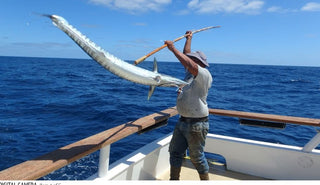Every missed strike has a reason. The professionals don't call it bad luck; they call it poor setup. That's why serious anglers spend more time fine-tuning gear than bragging about catches, because the small details turn chances into results.
Every detail counts- from the sharpness of your hooks to the way your Wahoo lures cut through current. Experienced anglers know that maximizing hookup ratios is just about fishing smarter.
The Anatomy of a Solid Hookup
A solid hookup starts before the strike ever happens. It's about preparation- the right gear tension, lure presentation, and how you react when the bite comes.
Check your hooks first. Even high-end models dull after a few trips. Keep a hook file handy and touch them up often- that tiny edge difference can mean the hook slides through cartilage instead of slipping off.
Next, consider your leader setup. If it's too stiff, the fish feels resistance early, and if it's too soft, you lose control when it turns. For marlin, wahoo, and tuna, balance flexibility with strength. A 200-300 lb fluorocarbon leader gives control without compromising movement.
And finally, reaction time. You can't pause when the line jumps. Keep steady tension and drive the hook with authority.
Dialing in Your Gear
Your rod and reel setup dictate how much control you keep when the fish runs. Many anglers underestimate the role of drag pressure and rod power in achieving better hookup consistency.
Start with your drag. Set it at roughly 25-30% of your line's breaking strength. If you're fishing 80-lb mono, keep drag between 20-25 lbs. That gives enough tension to bury the hook but lets the fish run cleanly without tearing out.
Rods should match your target and trolling style. Fast-action rods deliver power quickly- great for quick hook penetration on fast hitters like wahoo. For tuna, a moderate-fast rod helps absorb surges while maintaining steady pressure.
Keep reel maintenance sharp. Salt and sun kill drag smoothness faster. A sticky drag on a big strike often ends with slack line. Seasoned anglers test drag flow every trip- smooth, consistent pull is the mark of a tuned reel.
How Lure Choice Shapes Hookups
You can't talk hookups without talking lures. Every species reacts differently to speed, color, and movement, and that is where smart selection makes a difference.
For fast-moving predators, lures need to run clean and tight at high speed. Wire leaders prevent bite-offs, but remember- too thick a wire can alter lure action. Streamlined skirts and balanced heads keep the wobble consistent even past 15 knots.
When chasing tuna, depth and profile matter most. Tuna lures with moderate heads or bullet designs track straight and handle variable speeds better. Position them mid-spread, slightly back from your prop wash, where the turbulence clears.
And never overlook surface strikes. Tuna Poppers create commotion that triggers aggression, especially in calm water or low-light hours.
Hook position on each lure also matters. Double-hook rigs can help in open water, but make sure they don't hinder lure movement. The best anglers test every rig in the water before setting it- if it spins, adjust it.
The Mistakes That Cost Hookups
Even experienced crews lose fish for the same few reasons: poor line tension, bad angles, or mismatched lure spread.
Running too many lines is one of them. More is not always better. An overloaded spread tangles faster, and it's hard to monitor every lure's action. Stick with a layout you can watch- clean, even spacing with varied lure heads.
Another common issue: overreliance on drag. If your line's always under heavy pressure, you're setting yourself up for tear-outs. Let the rod work. Its bend is your buffer. Learn how it loads up and releases- that's your shock absorption in rough fights.
Lastly, impatience during the fight. Once the hook's set, it's about rhythm. Pump, reel, and recover steadily. Jerky movements create slack, and slack gives the fish room to spit the hook.
Turning Consistency Into Skill
The anglers who consistently land fish don't chase trends; they master fundamentals. They know their setups inside-out- what drag feels right, how each lure swims, when to back off pressure, and when to apply more.
Pay attention to how your spread behaves at different speeds. Watch lure positions in current and adjust to balance tension. Review how often you get short strikes versus solid hookups. Those small observations turn into instinct over time.
And don't ignore lure rotation. Switch between lures that create different bubble trails or vibration frequencies. Predators react differently depending on current, sunlight, and bait presence. The right rotation keeps them guessing and biting.
A Final Word
Hookup success is built on detail. Every sharp hook, tuned reel, and perfectly swimming lure adds up to consistency.
If you're ready to upgrade your spread or need gear that performs when it counts, explore the premium selection of lures designed for precision and strength.
Call us at MagBayLures to get the right setup for your next big run- because good gear doesn't just catch fish, it keeps you in the fight longer.

